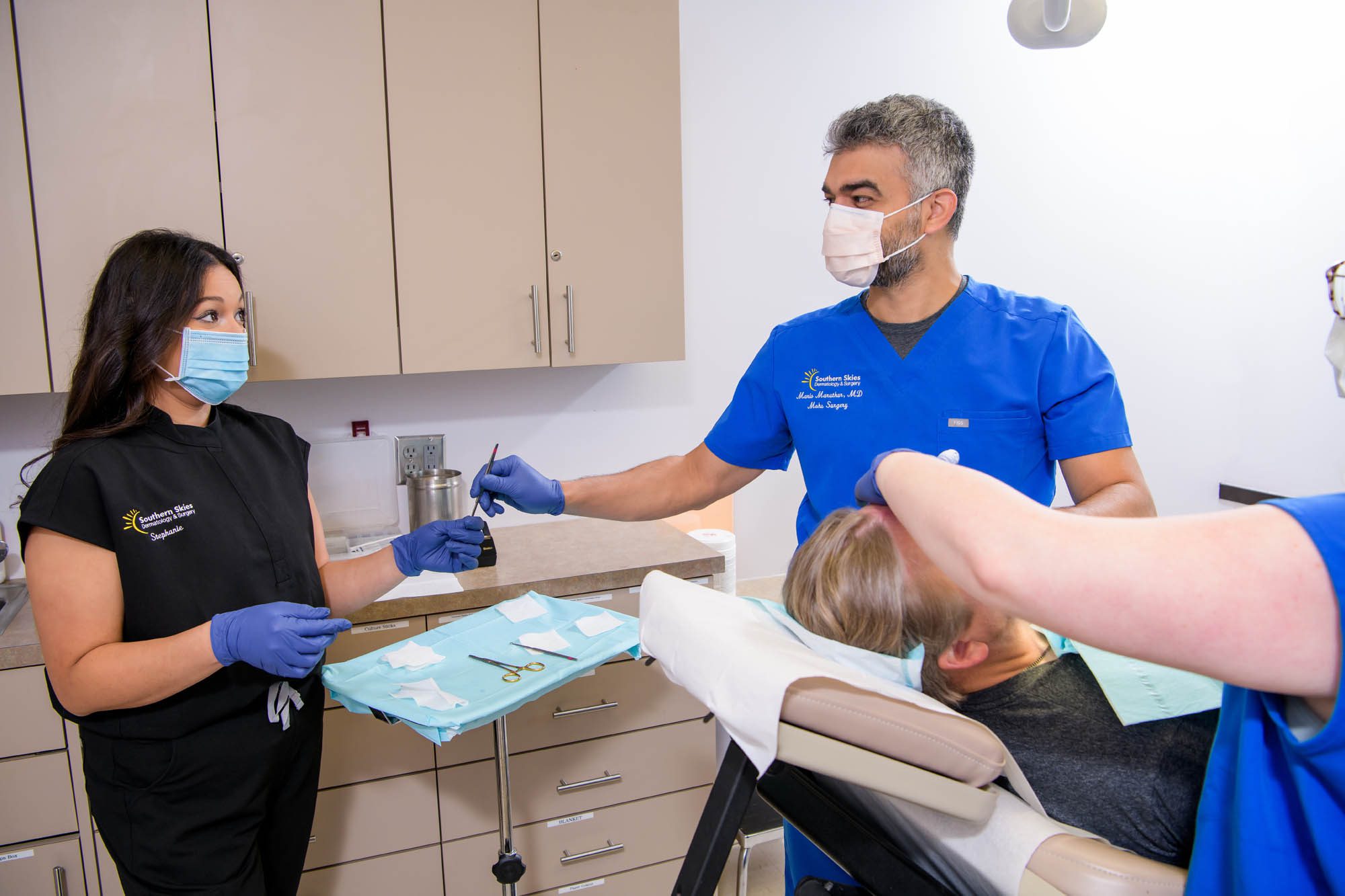Mohs Micrographic Surgery
Birmingham’s Top Mohs Micrographic Surgery Practice
Mohs skin cancer surgery, also known as Mohs micrographic surgery, is the top technique in treating skin cancers right now. It’s the most effective technique for completely removing basal cell carcinomas (BCCs) and squamous cell carcinomas (SCCs), resulting in the highest cure rate and lowest recurrence rate of any skin cancer treatment.
-
 Mohs surgery allows for the complete removal of non-melanoma skin cancer while doing minimum damage to other skin.
Mohs surgery allows for the complete removal of non-melanoma skin cancer while doing minimum damage to other skin.
-
 It is the only skin cancer treatment in which 100 percent of the peripheral and deep margin of the skin is assessed for remaining tumors. The surgeon looks at all of the skin edges and depth under a microscope to ensure that every cancer cell is removed. We can see individual cancer cells under the microscope, and you can see them too! Just ask Dr. Mario, and he will happily give you a tour and show you what the cancer cells look like under the microscope!
It is the only skin cancer treatment in which 100 percent of the peripheral and deep margin of the skin is assessed for remaining tumors. The surgeon looks at all of the skin edges and depth under a microscope to ensure that every cancer cell is removed. We can see individual cancer cells under the microscope, and you can see them too! Just ask Dr. Mario, and he will happily give you a tour and show you what the cancer cells look like under the microscope!
-
 Layers of skin are gradually removed and examined under the microscope, allowing the doctors to verify that all skin cancer cells have been removed.
Layers of skin are gradually removed and examined under the microscope, allowing the doctors to verify that all skin cancer cells have been removed.
-
 Mohs surgery requires an on-site laboratory to process the skin after it is removed and put the tissue on a slide for pathologic examination by the surgery.
Mohs surgery requires an on-site laboratory to process the skin after it is removed and put the tissue on a slide for pathologic examination by the surgery.
-
 An interesting fact of Mohs surgery is that the surgeon also acts as the pathologist, so patients get two doctors in one when they have Mohs surgery performed by a fellowship-trained Mohs surgeon.
An interesting fact of Mohs surgery is that the surgeon also acts as the pathologist, so patients get two doctors in one when they have Mohs surgery performed by a fellowship-trained Mohs surgeon.
-
 Mohs surgery is usually performed as an outpatient procedure under local anesthetic, so patients do not have to go under general anesthesia in an operating room.
Mohs surgery is usually performed as an outpatient procedure under local anesthetic, so patients do not have to go under general anesthesia in an operating room.
-
 Mohs has a 99 percent cure rate, studies show.
Mohs has a 99 percent cure rate, studies show.
About Mohs Skin Cancer Surgery
Here at Southern Skies, our staff Mohs surgeon, Dr. Mario, focuses 100 percent of his clinical practice on this advanced and complicated procedure. Thus, Mohs surgery has become a core focus of our medical practice. Dr. Mario is one of the best-trained Mohs micrographic surgeons in the United States, having completed his residency at Emory University with a fellowship in Mohs Micrographic Surgery and Dermatologic Oncology (MSDO) at the world-renowned Memorial Sloan Kettering Cancer Center. We believe in educating our patients thoroughly about this procedure so they can be reassured that they are getting the highest level of skin cancer treatment available in the United States.

Frequently Asked Questions
What is the process for Mohs surgery like?
Mohs surgery is a process that includes surgically removing skin cancer, checking the bottom and side edges under the microscope, and then fixing the skin defect after the cancer cells are removed.
After checking for your appointment, you will be brought back to a surgical suite. The medical assistant will ask you a series of intake questions, including any blood-thinning medications you are taking or any allergies you may have. Dr. Mario will then come in and examine the skin cancer location, mark the site, discuss the procedure with you, and answer any questions or concerns you may have.
The cancer is removed after the medical assistant numbs the area with lidocaine, according to Dr. Mario’s initial markings. Unique markings are made on the skin and removed tissue to create a tissue map. We typically mark at 12, 3, 6, and 9 o’clock, allowing us to create a map using a clock face as coordinates. The tissue (skin cancer) is then taken to our on-site pathology laboratory and processed. The tissue is frozen, cut into tiny slices (~7 micrometers!), placed on a microscope slide, and then stained.
Dr. Mario then examines the edges of the tissue under the microscope. One hundred percent of the edges (margins) are examined, including all the skin around and all the skin underneath. We can see both the individual cancer cells and inflammation (the body’s response to the cancer cells; “where there’s smoke, there’s often fire”). If any cancer cells or dense inflammation are left at the edge, we return to that area using our unique map markings and remove another thin layer. We repeat this process checking the edges each time until 100 percent of the skin cancer has been removed.
Once we are confident that the skin cancer is all out, Dr. Mario fixes the defect (hole) left behind by the skin cancer removal surgery. Fixing a hole in the skin after skin cancer is very different than cosmetic plastic surgery. Dr. Mario has special fellowship training and board certification to perform skin cancer plastic surgery reconstruction. When repairing the defect after Mohs surgery, Dr. Mario takes into construction any nearby vital structures such as the eyes and lips to ensure that they remain fully functional. Then he considers the aesthetics of the repair to leave behind minimal scarring and hide scar lines so that in 6-8 months, no one will know you had surgery!
Please plan to be at our offices for a minimum of two hours and up to the entire day, depending on the size of your skin cancer, how many layers it takes to completely clear it, and the type of reconstructive surgery it takes to repair the defect after cancer removal. Also, please be aware that even though you may have a single small spot, the patient in the next room may have an extensive cancer that requires extra attention, which may result in a longer wait time. Even though this can feel unfair at the moment, please know that our surgery team will take the same time and care with you should you need extra attention.
Does Mohs skin cancer surgery have side effects?
Overwhelmingly, Mohs surgery in our office goes off without a hitch and with only minor discomfort. However, complications can include pain and soreness at the surgery site for 2-3 days after the surgery. The discomfort can last longer in some locations, such as the lower legs. Patients on blood-thinning medications such as aspirin, Plavix, coumadin, and Eliquis may experience minor bleeding/oozing after the procedure. Rarely (~1/100) will patients develop a post-operative infection, which presents as worsening pain at the surgery site 3-4 days after the procedures.
Patients commonly develop foreign body reactions against the suture material under the skin. This suture takes 2-3 months to dissolve, and sometimes the body’s immune system can attack it, causing tenderness, swelling, and some oozing bumps where the sutures are. Other more rare complications can occur. To address this, we provide after-hours on-call access to Dr. Mario for all patients and a text number monitored by the entire surgery team. We also call patients the same day or the next day after their surgery to check on them. Lastly, Dr. Mario calls all his surgery patients on Friday or over the weekend to check in.
How long does it take to recover after Mohs?
Mostly, surgical sites heal well one week after Mohs. We typically recommend a lower activity level for 2-3 weeks and then gradually resuming more strenuous physical activity. The sutures on top of the skin are typically removed or dissolved 1-2 weeks after surgery (depending on the type). The sutures under the skin usually take 2-3 months to dissolve. Scars take 9-12 months to fully mature, so the complete healing process is up to one year. The goal for healing is for there to be minimal scarring and little to no signs that a surgery was performed at the one-year mark.
Our Locations
48 Medical Park Dr E #458, Birmingham, AL 35235
- Get Directions
423 23rd St N, Pell City, AL 35125
- Get Directions
300 Medical Center Dr #402, Gadsden, AL 35903
- Get Directions

1400 Highway Dr Ste C, Oxford, AL 36203
- Get Directions
Make Your Appointment Today
Your skin’s health is vital. Our team of world-class doctors and surgeons are here for you, whether you need a full-body examination, biopsy, or skin cancer treatment, in a clean and caring environment. Call us today and schedule an appointment! We’re looking forward to seeing you.

